Shootout: Galaxy S6 Camera Defeats iPhone 6
Samsung's new super phone beats Apple's best handset with image stabilization, a larger aperture and new white-balance tech.


One epic, multigenerational war dominates the smartphone world: Apple iPhone vs. Samsung Galaxy S. Photography is a main battleground. Apple launched its excellent iPhone 6 and 6 Plus phone cams in September 2014. Now it's Samsung's turn with the Galaxy S6 and Galaxy S6 Edge, which have the same camera. The biggest upgrades are a larger aperture for low-light photography and an infrared sensor to improve white balance. Samsung seems to have tweaked how it processes images, too, favoring lighter exposures with less contrast.
We pitted a Galaxy S6 and S6 Edge against two iPhone 6 Plus models for 12 rounds of image-quality tests with different types of subjects and lighting conditions. By using multiple units and getting consistent results, we ensured that we didn't have a defective phone.
MORE: Galaxy S6 Edge Full Review
Owing to cloudy weather, our initial rounds were primarily indoors or under diffused sunlight — where the Galaxy S6 soundly beats the iPhone 6 Plus. After we added sunny weather tests, the results were much closer. See for yourself how the two cameras compare. (Click on any image to bring up a larger version.)
Round 1: Daylight Still Life
We start with the easiest test — shooting objects that don't move under sunlight, albeit diffused sunlight owing to gray New York City skies. Photos from both cameras look great. The iPhone 6 Plus photo (at right) shows a hint of extra green, yielding slightly fluorescent-looking greens in the apples. The Galaxy S6 photo puts a bit too much blue in the image, giving the apples a slight purplish tint. But this is nitpicking. Both show crisp detail, though the Galaxy S6 photo is a tad sharper, owing to its 16-megapixel sensor, compared to the 8-MP chip in the iPhone 6 Plus camera.
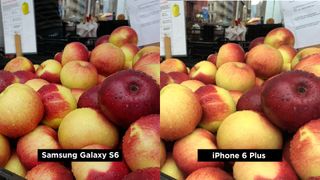
Winner: Tie
Round 2: High-Color Still Life
We saw a clearer difference in these shots of brightly colored flowers, mostly under cloudy sunlight, with a bit of fluorescent lighting from the vendor's stall. The Galaxy S6 photo, at left, has a pleasing higher color saturation. It also shows more detail — due not only to higher resolution but also to better contrast, which brings out fine shading in the petals. The iPhone 6 Plus photo has a hazy appearance. We sometimes see this due to the camera's tone mapping, which tries to pull back areas that are overexposed. It goes too far here, producing a flat image.
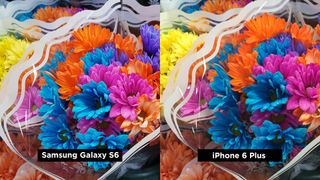
Winner: Galaxy S6
MORE: iPhone 6 Camera Quirks – and How to Fix Them
Round 3: Daylight Portrait
Both cameras capture the skin tone of our colleague Dave pretty well. The iPhone 6 Plus image makes his face look brighter and clearer, though; whereas it looks a bit flat in the Galaxy S6 photo. The iPhone 6 Plus pic also shows a stronger black in his coat. It's a close call, but the iPhone 6 Plus does better overall.
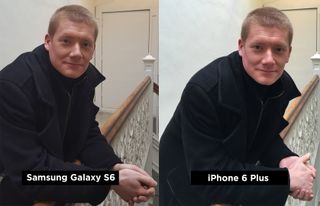
Winner: iPhone 6 Plus
Round 4: Indoor Still Life
Low-light performance is a strong point for the iPhone 6 and a priority for the Galaxy S6. This photo shows that Samsung has not only closed the gap but actually pulled ahead. Not surprising is that its higher-resolution camera captures more detail, as in the label on the Captain Morgan's bottle. But further, the Galaxy's default real-time high dynamic range (HDR) produced a better exposure, not only bringing up the shadows but also capturing more detail in highlights.
That, as much as resolution, makes the text on the frosted Absolute Mandarin bottle sharper. The Galaxy S6 captures more and brighter highlights, too, as on the brown rum bottle at the left. The clear bottles show complex reflections and diffractions in the S6 photo that appear at best as blobs in the iPhone image.
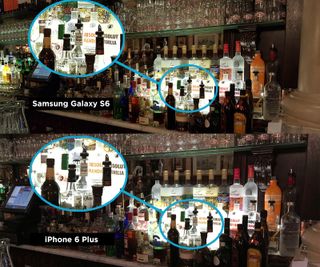
Winner: Galaxy S6
Round 5: Indoor Portrait
Both phone cameras captured nice photos of our co-worker Valentina in a dim hallway with mixed fluorescent and LED lighting. However, the iPhone 6 Plus photo appears a bit flat compared to the higher-contrast Samsung image, and it doesn't capture the reddish highlights in her hair.
The Galaxy S6 photo better reflects the color of the lighting. Perhaps this is due to the infrared sensor, but we can't say for sure. The higher-resolution Galaxy S6 photo also shows much finer detail, evident in her scarf.

Winner: Galaxy S6
Round 6: Low-Light Portrait
This is an extreme-low-light test — images taken with only dim overhead light. There are several variations between the two photos: for example, the Galaxy S6 image appears too warm while the iPhone 6 Plus image looks greenish. But the glaring difference is that the iPhone 6 Plus photo shows yellow splotches on her face, such as her forehead and under her eyes. We've occasionally seen the iPhone 6 tone mapping turn overexposed areas yellow, but this is worse than usual.
The Galaxy S6 photo also appears a bit brighter, possibly due to its f/1.9 aperture, which lets in about 30 percent more light than the f/2.2 aperture of the iPhone 6 Plus camera.

Winner: Galaxy S6
Round 7: Flash Photo Portrait
Sometimes, a camera simply needs to use a flash, and here, the Galaxy S6 beats the iPhone in a few ways. It shows far more detail, again evident in her scarf. Colors also appear more accurate in the Galaxy S6 image. The Samsung's flash is perhaps more powerful than some people might want, but the photo is not overexposed.
The most noticeable aspect of the iPhone 6 Plus photo is that there are yellow splotches, especially on her cheek and neck, due to failed tone mapping. The iPhone 6 Plus image also has a worse red-eye effect, but this could just be a matter of chance.
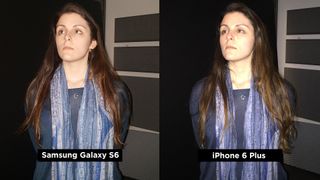
Winner: Galaxy S6
Round 8: Sunny Cityscape
Both the iPhone 6 Plus and Galaxy S6 cameras performed well — as they should — in this cakewalk photo test. People we asked around the office preferred the warmer colors of the iPhone 6 Plus photo, and so it takes the round, but only by a hair. The Galaxy S6 photo is also of high quality.
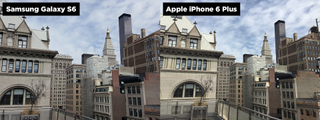
Winner: iPhone 6 Plus
Round 9: Backlit Street Scene
There was no contest in this comparison. When the subjects were backlit, the whole image appeared faded in the iPhone photo, while the Galaxy S6 photo retained good contrast. We saw similar results in other backlit shots taken with both cameras.
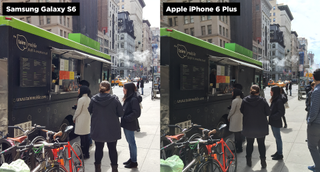
Winner: Galaxy S6
Round 10: Front-Lit Street Scene
The differences between the two phones go away when strong sunlight hits the front of the subject. Here both cameras captured detail well, and the fast phase detection autofocus in both cameras helped each capture a sharp image of the moving subjects. People viewing both photos tended to prefer the iPhone 6 Plus image for its warmer tone, but again, the differences are subtle.
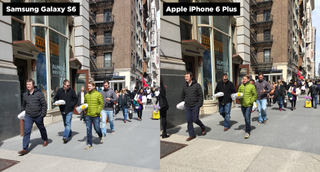
Winner: iPhone 6 Plus
Round 11: Sunlight Group Portrait
The iPhone 6 Plus won our competition in the portraits of Dave under diffused sunlight, and it triumphs again in this very bright photo of Dave, Valentina and our colleague Sherri — with richer, truer colors and far stronger contrast. This is a pattern we have consistently seen between the two cameras in photos under intense sunlight. If you're going to the beach, the iPhone will certainly serve you better.
The iPhone 6 Plus image is far from perfect, though. Tone mapping has flattened out details and produced those characteristic yellow spots on Valentina's and Dave's faces. Because the S6 image retains more tonal detail, it might ultimately produce a better photo after editing. But straight from the camera, the iPhone 6 Plus image looks much richer.
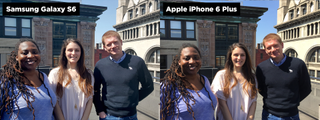
Winner: iPhone 6 Plus
Scorecard

Bottom Line
In the past, iPhone cameras were the most accurate in color reproduction and exposure, and produced the best low-light images. All of those advantages made up for the iPhone's resolution, which is lower than most competitors'. Now in addition to offering twice the resolution, Samsung has refined its image processing and increased its aperture size to exceed the iPhone's performance in low light.
By day, the differences are closer, with the winner often a matter of personal preference, although the iPhone 6's tone mapping saves images that the Galaxy S6 would overexpose in very bright sunlight.
Tallying up all the conditions you might shoot under, the Galaxy S6 ultimately has the more capable camera. However, the iPhone 6 Plus remains a very strong competitor.
Follow Sean Captain @seancaptain and Sam Rutherford @SamRutherford. Follow us @tomsguide, on Facebook and on Google+.
Sign up to get the BEST of Tom’s Guide direct to your inbox.
Upgrade your life with a daily dose of the biggest tech news, lifestyle hacks and our curated analysis. Be the first to know about cutting-edge gadgets and the hottest deals.
Sam is a Senior Writer at Engadget and previously worked at Gizmodo as a Senior Reporter. Before that, he worked at Tom's Guide and Laptop Mag as a Staff Writer and Senior Product Review Analyst, overseeing benchmarks and testing for countless product reviews. He was also an archery instructor and a penguin trainer too (really).
